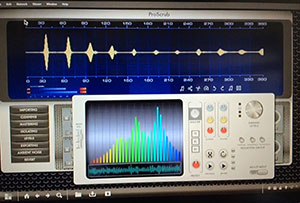Audio Analysis Software Used By Sherlock Holmes In Elementary?
In a recent episode of the CBS show Elementary, called “Corpse de Ballet,” Sherlock Holmes used an audio software program to help solve a crime.
Since I am always on the lookout for all things audio on TV, we rewound the scene and paused on a close-up of the software. It was called “ProScrub.” The problem is…it doesn’t exist. At least not that I can find.
To the left is a picture of the software from the episode. I must have looked for hours all over the internet for audio software that looked anything like this. And my wife – “the Google Whisperer” – did the same.
And if she can’t find it, then it probably isn’t out there to be found. However, there are tons of audio editing, recording, mastering, and analysis programs available. So the odds that we found them all is very low.
So, if you have any knowledge of a program called ProScrub, or what real software was used if “ProScrub” is a name made up for the episode, please leave a comment below. I would very much like to know.
Sherlock used the program analyze a recording someone had made of a phone call made by the suspect. He stated that because there were two different types of ambient noise in the audio recording, it meant that it was a recording of a recording – the ambient noise from the device recording the phone call, along with the ambient noise around the person at the other end of the phone call.
That is interesting, since the name of the program is ProScrub, and what Sherlock did was not “scrubbing.” Scrubbing is not what it sounds like, which would lead most folks to think it had something to do with cleaning the audio. Not so.
In the old days – before digital audio software which allows you to see (rather than just hear) the audio, if you wanted to find a very specific place in the audio, usually just before or just after a sound, you could stop the tape (yeah, that’s what we used to use to record audio:)) and slowly move it back and forth (which you could do with by literally turning the tape reels with your hands) across the player head of the tape machine.
Nowadays, with the waveforms visible on a computer screen, you can just put your cursor where you need it to be and zoom in. You really don’t need scrubbing to pinpoint your location in audio anymore. But still, a lot of programs still have a “scrubbing” function.
It’s funny when a TV program tries to use terms they don’t quite understand to explain something technical. But still, the buttons down the left side of the ProScrub screen suggest some pretty useful audio functions:
- Importing
- Cleaning
- Mastering
- Isolating
- Levels
- Exporting
- Ambient Noise
- Revert
There are lots of programs that can do all of these things. typically you’d want a program that specializes in “audio editing.” Examples of such programs would include Adobe Audition and Sony Sound Forge. Of course there are dozens of others out there.
I’d still really be interested in what the real program used in Elementary was. So if you know, please leave a comment. If I find out – either from you or The Google Whisperer, I’ll update this post.
Cheers!
Ken


I just found your post in a similar way you posted it.
I work with audio and like computers, so when I saw that episode I did the same thing as you did… I just didn’t publish an article yet 🙂
My first thought is that though the hardware is a iMac, the software is not from Apple. If you look at the User Interface of the window manager you will notice that it is a Linux, probably ubuntu based running a custom setting for Gnome, Cinnamon or Openbox window manager.
I supposed the studio don’t want to use a proprietary software so they may get away without paying royalites to whatever company, the most clear evidence to this is the fact that though it undeniable that Sherlock is using an iMac, when they show the screen of the computer, the apple logo was removed from the botton of the monitor.
It is definetely a Linux OS, because:
1- Linux is able to run on an Apple computer
2- Linux is highly costumisable, so whoever has the knowledge to do change the look and feel of the interface can do it.
3- GTK is a very simple language to create user iterfaces for any application, so with no much expenses the studio could have someone creating an application to analise sound and show the wave of the recording, and named some buttons that don’t nescessarily do what is is labeled.
I think I am watching too much Elementary 🙂
Thanks for the info Maurice!